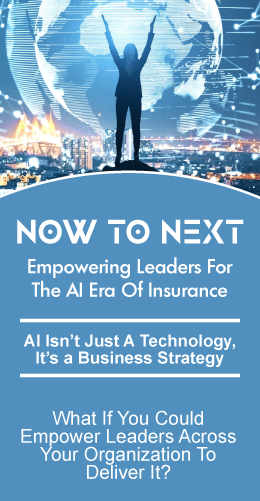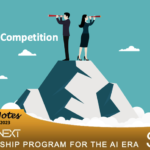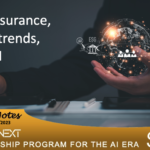
The property and casualty (P&C) insurance landscape is undergoing a monumental shift driven by advanced technological forces. Today AI is taking the lead. In an era where experiences outside the industry shape customer expectations, P&C insurers must adapt with agility and focus to not just stay relevant but to lead in a competitive market.
Trends Reshaping The Competitive Landscape
Personalization
Personalization in P&C insurance goes beyond traditional segmentation and pricing models. Insurers are tapping into big data and predictive analytics to understand individual risk and preference profiles, crafting policies that cater to the unique needs of each customer. The use of telematics for personalized premiums and IoT devices for dynamic risk assessment are instances where personalization is already reshaping the industry. Insurers are learning to navigate regulatory constraints and ethical considerations while pushing the envelope on customized offerings.
AI empowers insurers to create more personalized insurance experiences by analyzing vast datasets that include consumer behavior, preferences, and risk profiles. Advanced algorithms can uncover insights that inform product design and enable dynamic pricing models. AI can detect patterns in data that humans may overlook, allowing for a more nuanced understanding of individual needs and the provision of tailor-made insurance solutions.
Digitalization
The digitalization of P&C insurance encapsulates technology to streamline and enhance all aspects of the insurance process. This includes claim processing, fraud detection, mobile apps for customer engagement, and virtual assistants to handle inquiries. Integrating these digital tools is about transforming the insurance value proposition to deliver a 21st-century customer experience.
AI is the cornerstone. From chatbots that provide instant customer service to algorithms that automate claims processing, AI technologies enable insurers to operate more efficiently and effectively. Moreover, AI’s predictive capabilities allow insurers to anticipate customer needs and market shifts, positioning them to offer relevant solutions proactively.
Embedded Insurance
Embedded insurance offers a channel for growth by bundling insurance products with other purchases such as cars, homes, or travel bookings. This trend is facilitated by the emergence of API-driven platforms that enable easy insurance integration into the purchase journey of goods and services. The result is a more frictionless experience for the consumer and an expanded market for insurers. Success in embedded insurance requires a deep understanding of various customer purchasing journeys and the agility to embed insurance products in those paths.
AI enhances embedded insurance by enabling real-time analysis for integrating insurance offerings with product or service purchases. For instance, when purchasing a vehicle, AI can quickly assess the buyer’s information to suggest personalized insurance coverage options embedded within the sales process, with minimal input from the buyer and in a non-intrusive manner.
Omni-channel Engagement
Customers expect to interact with insurers across various channels, including in-person, online, and through mobile devices. An omnichannel strategy must provide a seamless and coherent experience, regardless of the channel. It requires sophisticated data integration, ensuring the same customer data inform all touchpoints to provide a personalized and consistent service.
AI supports omni-channel engagement by providing a unified view of the customer across all channels. It can track interactions and preferences to deliver a cohesive experience, whether the customer is on a web chat, in an app, or speaking with a call center representative.
Customer-centricity
Today’s insurance customers demand products and services that not only meet their needs but also align with their values. Insurers respond by engaging in two-way dialogues with customers, soliciting feedback through various channels, and using this information to shape service offerings. This focus on customer-centricity has become a key differentiator in a market where product features can be quickly replicated.
Insurers utilize AI to process customer feedback across multiple platforms, gain insights into customer satisfaction, and identify areas for improvement. AI tools can also personalize communications and product offerings at scale.
Digital Empowerment Of The Entire Value Chain
Digital empowerment involves using technology to enhance every interaction along the customer journey. From the initial product inquiry to underwriting to claims and renewal, each step is an opportunity to use digital tools to improve service delivery. A digitally empowered value chain is resilient, adaptable to changing market conditions, and able to exceed customer expectations continuously.
AI technologies digitize and optimize each part of the insurance value chain. For instance, AI-enabled analytics tools can refine risk assessment models or identify fraudulent claims more accurately. In customer service, AI facilitates a more responsive and interactive policy management system, allowing for routine inquiries and transactions to be managed without human intervention.
AI is also revolutionizing the role of agents and brokers in the insurance value chain by enhancing their capability to offer customized, knowledgeable advice and service. Through AI-powered analytics and customer relationship management (CRM) tools, agents and brokers are equipped with real-time insights into customer behaviors, preferences, and potential risk profiles. These tools help them to identify cross-selling and up-selling opportunities by suggesting tailored insurance products to clients. Additionally, AI-driven chatbots and automated workflows allow agents more time to focus on high-value interactions by reducing their administrative burden. Finally, AI enhances the accuracy of risk assessment, allowing brokers and agents to price policies more competitively and improve the overall customer purchasing experience.
Speed and Efficiency
In the digital age, customers have come to expect rapid responses and resolutions. In P&C insurance, this means providing instant quotes, real-time policy amendments, and swift claims processing. Technology is the enabler here, with insurers investing in automation to ensure they are not only fast but also accurate and consistent in their operations.
Speed is vital in insurance, and AI significantly cuts down processing time. By employing machine learning models, insurers can provide instant quotes and rapid claims settlements. AI can automate underwriting tasks that traditionally took days to complete, doing them in a matter of minutes while improving accuracy and reducing errors.
Additionally, AI’s integration with low-code/no-code platforms expedites the development and deployment of insurance applications. By simplifying the creation process, these platforms enable insurers to adapt and innovate in response to changing market demands swiftly. Insurers can utilize pre-built templates and intuitive interfaces, reducing reliance on technical staff and shortening development timelines. This democratization of app development allows for rapid prototyping and iteration, fostering an agile environment for customer-focused solutions. Consequently, AI-driven low-code/no-code tools are becoming pivotal in enabling insurers to offer timely, relevant, and efficient services to policyholders.
Transparency
Transparency is a cornerstone of trust in the insurance industry. It entails clear communication about policy terms, pricing, claims processes, and the rationale behind underwriting decisions. In an era where social media and online reviews can significantly impact reputation, maintaining a stance of transparency is essential for insurers.
AI can play a role in demystifying consumer insurance by powering interfaces that explain policies and decisions in plain language. It can also ensure that claims and pricing decisions are made on a consistent and fair basis, which can be audited for fairness and compliance, thus maintaining regulatory transparency.
Ecosystem Partnerships
To create and deliver value in new ways, insurers are forming ecosystem partnerships with a diverse set of players, including tech companies, automakers, home builders, and smart home technology providers. These partnerships allow insurers to offer a wider range of services and products, facilitating a move from indemnification to prevention.
AI facilitates the analysis of big data generated from ecosystem partnerships, which can lead to the development of new insurance products and services. For instance, by analyzing data from smart homes or connected vehicles, AI can help insurers understand risk in real time and create bespoke insurance solutions that fit seamlessly into partner offerings.
Sustainability
Sustainability practices are increasingly influencing customer choices in P&C insurance. Insurers incorporate environmental, social, and governance (ESG) factors into their products and operations to appeal to eco-conscious consumers, manage risks more effectively, and comply with regulatory pressures.
AI assists insurers in analyzing environmental risks associated with their portfolios, predicting claims related to climate events, and identifying sustainable investment opportunities. AI can enhance the underwriting process by incorporating ESG risk factors, thereby aligning with broader corporate sustainability goals
Key Takeaways:
Personalization through AI: insurers leveraging AI algorithms gain a competitive edge by offering highly personalized insurance products and analyzing vast datasets to enable a deep understanding of individual customer profiles for tailoring offerings and pricing effectively.
Digitalization Boosted by AI: The adoption of AI, including machine learning and natural language processing, transforms customer service in P&C insurance, powering mobile apps and virtual assistants to deliver an exceptional digital customer experience.
Embedded Insurance with AI Integration: AI plays a pivotal role in embedded insurance by enabling seamless and intelligent product recommendations during the purchase process, thereby enhancing customer convenience and increasing conversion rates.
Omni-channel Experience Enriched by AI: AI assists in creating an integrated customer experience across various channels, ensuring consistency and personalization at each touchpoint, which is crucial for customer satisfaction and retention.
Customer-Centric Product Design Informed by AI: AI technologies enable the analysis of customer feedback and behavior, driving the development of customer-centric products and services that resonate with market demands and improve customer loyalty.
Digital Empowerment across the Value Chain: AI’s impact is broad and significant, touching every aspect of the insurance value chain, from risk assessment to claims processing, empowering customers and insurance agents/brokers with sophisticated digital tools.
AI-enhanced Speed and Efficiency: Utilizing AI not only speeds up quotes and claims processing but also synergizes with low-code/no-code platforms to expedite product development and deployment, offering insurers a rapid route to market with new innovations.
Transparency Facilitated by AI: Insurers using AI to demystify underwriting and pricing processes can foster greater trust and transparency, which is paramount for customer loyalty in the modern, informed marketplace.
AI as a Catalyst for Ecosystem Partnerships: Collaborative AI platforms enable insurers to integrate more deeply with partners across the ecosystem, unlocking new value streams and providing comprehensive solutions for customers.
Sustainability and ESG Integration via AI: By harnessing AI for ESG data analysis and reporting, insurers can not only improve their own sustainability practices but also offer customers insights into how they can contribute to a more sustainable future.
Critical Questions:
Data Utilization and Personalization: How is our organization using AI to analyze customer data for personalization? Can we use predictive analytics to design products that align with individual risk profiles and preferences?
Digital Customer Service Advancements: To what extent are AI technologies like chatbots and intelligent virtual assistants being deployed to enhance digital customer service? How are we measuring their impact on customer satisfaction?
Embedded Insurance Strategy: How is our strategy for embedded insurance evolving with AI integration? Are we leveraging AI to identify the right moments for offering insurance within the customer journey of purchasing other products?
Cross-platform Customer Engagement: How is AI being used to ensure a consistent omni-channel experience? Are our systems capable of providing a seamless customer journey across all platforms and touchpoints?
Customer Feedback Integration: How are we harnessing AI to process and act upon customer feedback? Is there a mechanism for real-time adaptation of products and services based on insights gained from AI analysis?
Empowerment of Agents and Brokers with AI: In what ways is AI empowering our agents and brokers to serve customers better? Do they have access to tools that streamline the customer engagement process and enhance the advice provided?
Speed to Market with AI and Low-Code/No-Code: Are we using AI in conjunction with low-code/no-code platforms to speed up our software development lifecycle? How are these technologies impacting our speed to market with new products and features?
Transparency in AI Decision-Making: How transparent are our AI-driven decision processes to customers? Do we have protocols to explain AI-based decisions, especially in underwriting and pricing?
Ecosystem and AI Partnerships: What is the status of our collaboration with technology and service providers in strengthening our ecosystem partnerships through AI? How does this collaboration enhance our value proposition?
AI-Driven Sustainability: How are we leveraging AI to enhance our ESG initiatives? Are we effectively using AI to assess and manage the sustainability performance of our operations and those of our clients?
Executive Actions:
Invest in AI and Analytics: Invest in AI technologies and data analytics tools. Allocate a budget towards acquiring and developing systems that allow for the deep personalization of insurance products.
Upgrade Digital Service Capabilities: Ensure the organization’s digital service platforms are AI-ready. Invest in training for staff to effectively manage and utilize AI tools like chatbots, mobile apps, and virtual assistants to enhance customer experience.
Promote Embedded Insurance Adoption: Encourage the development of embedded insurance by collaborating with product and service providers. Use AI to streamline this integration, making insurance a natural part of the customer’s purchasing journey.
Foster Omni-channel Consistency: Implement AI systems that provide consistent customer service across all channels. Use these tools to gather data that can lead to a more unified view of customer interactions.
Gather and Act on Customer Insights: Create channels for constant customer feedback and employ AI to analyze this data. This should inform product development and customer service improvements in an ongoing cycle.
Empower Frontline Decision-Making: Use AI to empower agents and brokers with real-time insights and decision-making support tools, enhancing their advisory role and responsiveness to client needs.
Leverage Low-Code/No-Code Development: Embrace low-code/no-code platforms backed by AI to expedite the development and deployment of new applications, allowing for faster response to market changes.
Maintain Transparency: Develop a policy to ensure transparency in AI-based decisions. Provide clear communication to customers about how AI influences their insurance services.
Integrate ESG into AI Strategies: Align AI strategy with ESG goals, ensuring that your company uses AI not only for economic gains but also to promote environmental and social well-being.
Build a Culture Ready for AI: Cultivate a company culture that is agile and AI-first in thinking. Encourage a mindset of continuous learning and adaptability to new technologies among all employees.
Develop AI Leadership Skills: Ensure leadership is equipped with the knowledge and skills to understand and oversee AI initiatives. This includes understanding the ethical implications and the ability to lead a tech-savvy workforce.
Summary
In a rapidly transforming industry landscape, property and casualty insurance leaders must act decisively to integrate artificial intelligence into their strategic vision. The urgency to adapt is heightened by the pace at which AI reshapes customer expectations and the competitive environment.
The immediate focus should be on leveraging AI to stay in front of competitive trends—personalization, digitalization, embedded insurance, omnichannel engagement, customer-centricity, digital empowerment, speed and efficiency, transparency, ecosystem partnerships, and sustainability.







